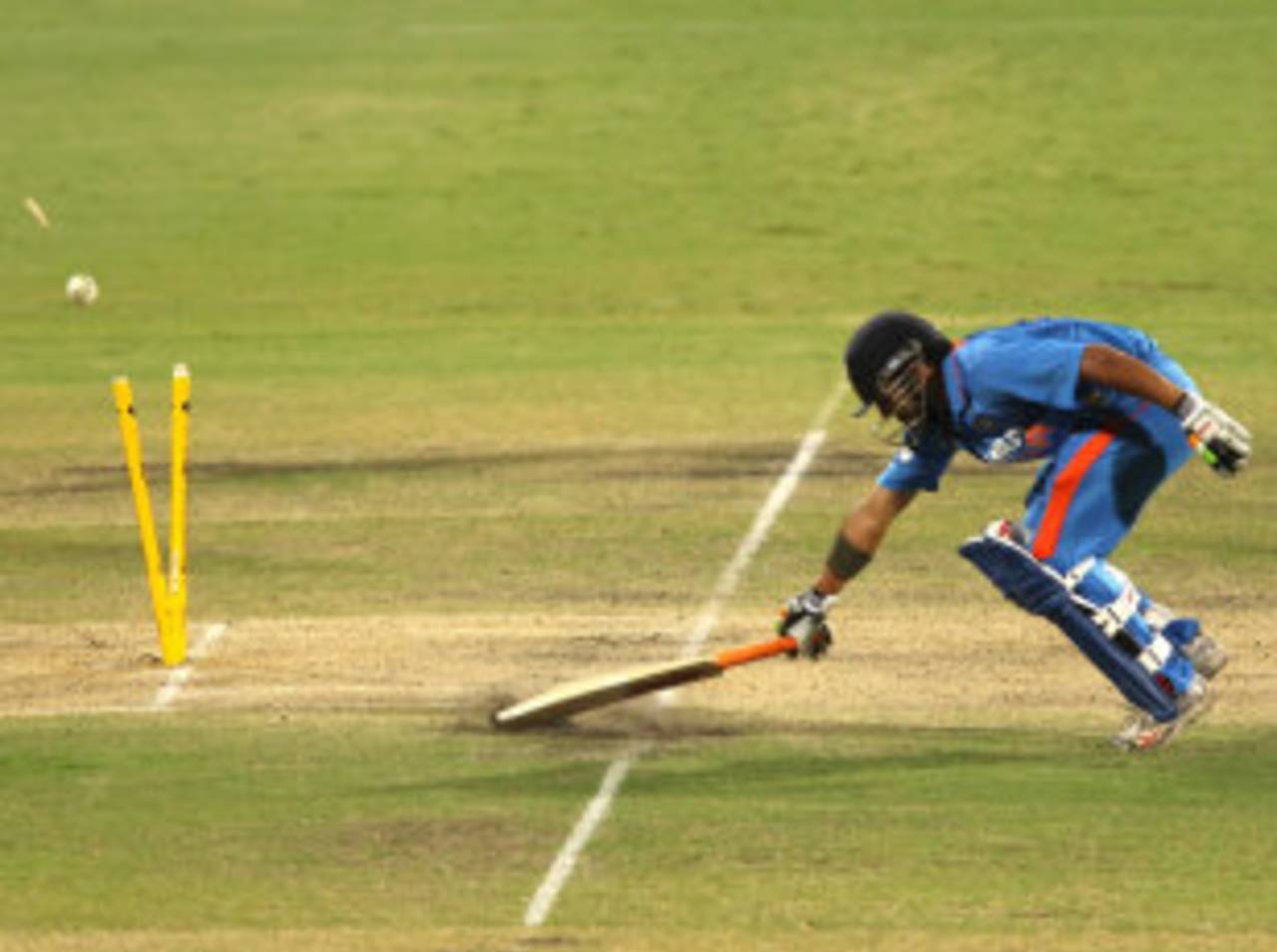Mankading is no grey area
Cricket needs to find a way to eliminate these anomalies because it is a game decided by the smallest of margins
Michael Jeh
25-Feb-2013

How can a batsman be allowed to blatantly take a start, when run outs are often decided by fractions of an inch? • Getty Images
Forgive me for continuing to bang on about the same topic but if international cricketers (and the system that governs them) keep repeating the same behaviours, perhaps it's necessary to keep bringing the same matter up for discussion. In my most recent blog, we discussed the Mankading incident involving Lahiru Thirimanne and whether the liberties that batsmen are taking constitute cheating or gamesmanship.
Yesterday in Hobart, Sri Lanka were quick to remind Michael Hussey that backing up too far was a global phenomenon and not unique to Sri Lanka. Despite Hussey looking a bit bemused when the umpire gave him a friendly warning via Mahela Jayawardene, video evidence clearly showed that Hussey was indeed guilty of stealing a few centimetres, by accident or design.
Today in Wellington, the issue was elevated from the sublime to the ridiculous when Lonwabo Tstotsobe was no-balled for overstepping the line and the video replay showed that a part of his heel was actually behind the line, although to be fair, it might have looked different from where the umpire was standing. This tiny fraction of a centimetre was enough to cost him a "free hit" which can prove to be a costly mistake. What was interesting though was that the replay showed the batsman, Kane Williamson, backing up a long way out of his crease at the time that Tsotsobe's foot was deemed to be a centimetre too short for the umpire's liking. So whilst the bowler is penalised for being a fraction over the line, the batsmen can be a few feet past the line and there is very little that the game can do to stop this blatant cheating.
Why is the bowler not given a warning that his foot was over the line in much the same way that the batsmen are expected to be warned when they are deliberately stealing a few precious centimetres? I'm afraid I no longer subscribe to the theory that it is accidental. It's happening too often for it to be accidental. In an era where run outs are adjudicated on by the third umpire and it often comes down to a tiny margin, almost a video frame, there must be some way to ensure that batsmen aren't taking the mickey.
Maybe for every run out involving the non-striker, they should pan back to the bowler's end and calculate the distance that the batsman was in front of the crease and deduct it from the distance by which he made his ground. After all, if you take a short run, even by the tiniest of margins, you have that run deducted from your score. So what's the difference between a short run and a batsman deliberately starting with an unfair advantage?
Cricket needs to find a way to eliminate these anomalies because it is a game decided by the smallest of margins. The difference between a nick and a play and miss is too small to even measure by a method other than Hot Spot or Snicko. We waste a lot of time on replays trying to figure out if a fielder on the boundary grazed the rope with any part of his body. Run outs and stumpings are sometimes decided by a split video frame. LBW decisions referred to the third umpire are subject to a fine line as to where the ball pitched. No-balls are called on the tightest of margins. Just about everything in the game relies on wafer-thin margins and yet, this aspect of the game remains open to blatant abuse.
Most other professional sports don't allow deliberate flouting of the lines of demarcation. Tennis, athletics, golf and a host of other sports that I haven't even thought of would surely not allow a competitor to deliberately be a foot over the line or off the mark. Can you imagine a golfer moving his putt a foot closer to the hole? Or a long jumper being allowed to leap from a long way past the mark? Or a rugby player being granted a try when he grounds the ball way in front of the line?
Perhaps the answer lies in dispensing with the notion of warning the batsman before you run him out. No other aspect of the game requires a warning before a penalty is incurred. It was a quaint and gentlemanly tradition in an era when backing up too far may well have been an absent-minded action but I'm too much of a cynic to think that this is not a deliberate ploy to steal an unfair advantage. It happens too often for it to be an accident. If it is an accident, it makes cricket a poorly administered sport that allows it to continue without some remedy. That's not acceptable when the rules of the sport rely on precision to the nth degree.
Michael Jeh is an Oxford Blue who played first-class cricket, and a Playing Member of the MCC. He lives in Brisbane